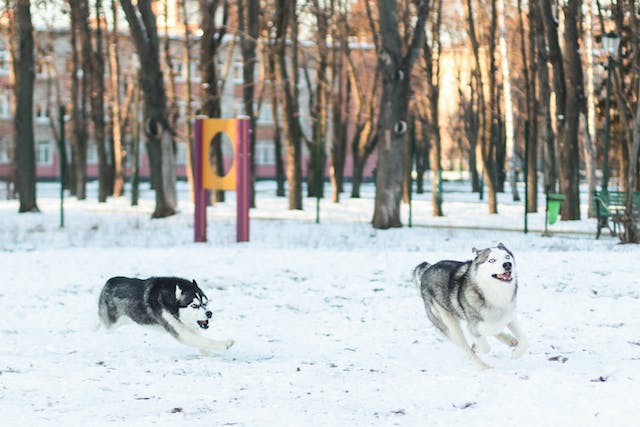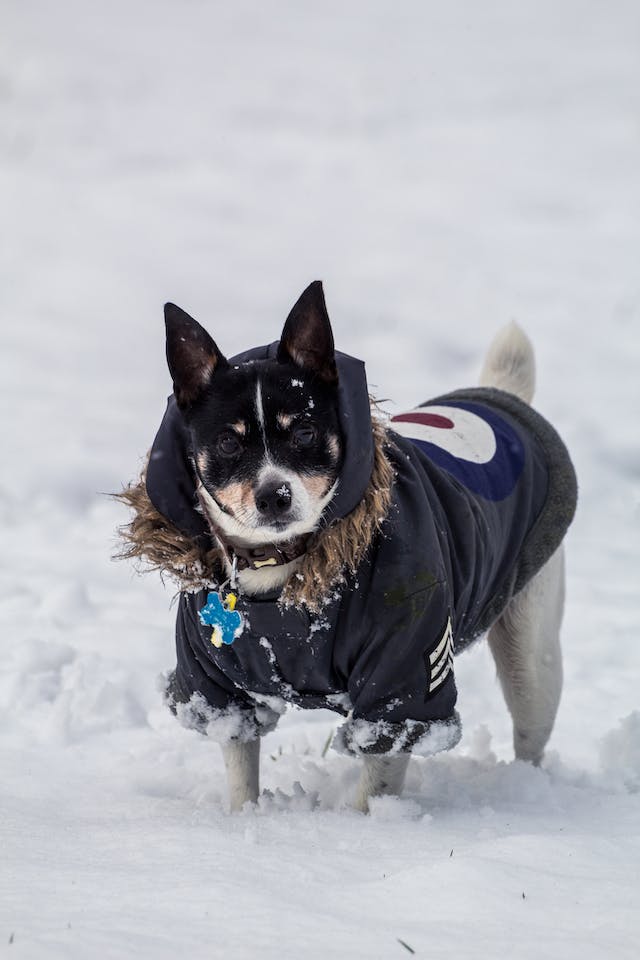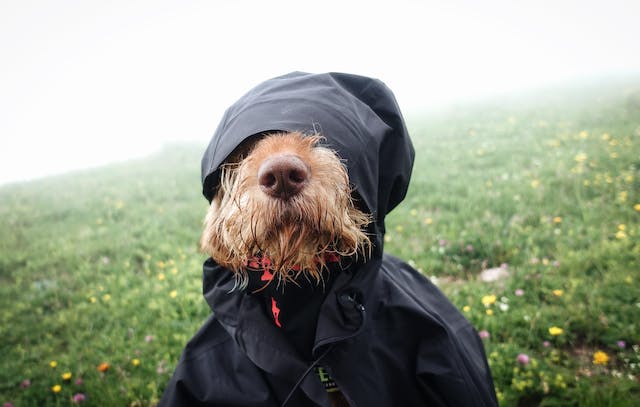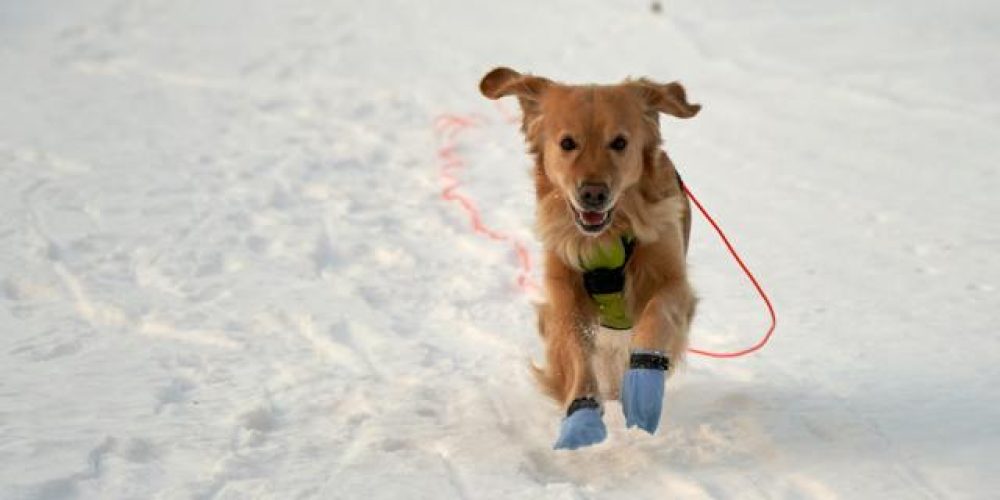Dogs feel the cold. Some breeds have thick coats and an inherited ability to tolerate cold. But just like humans, all dogs shiver and can suffer hypothermia and frostbite. Elderly dogs, puppies, and thin-skinned breeds are most at risk when the temperature drops.
Extremes of temperature bring everyday risks to dogs and their people. Most dogs will struggle when the temperature drops below 7 degrees, but all dogs risk hypothermia when it gets below -6. And remember, its not just the air temperature we need to be aware of. Wind chill, overcast skies and wet weather will all make the outdoors feel even colder. This article looks at the risk factors, recognising when your dog’s feeling the cold, and how to protect them against hypothermia. We’ll also offer some advice on what to do if your dog does get chilled and when to call the vet for help.
Why dogs feel the cold
Dogs are warm-blooded animals, just like humans. Their bodies generate heat from the inside by burning fuel (food). And they have hairy coats. When it’s cold, the hair stands on end. This traps a layer of air next to the body and body heat warms it. It becomes like a warm-air blanket.
Some dogs are bred to cope with cold climates. Breeds like Newfoundlands, Tibetan terriers, Akitas and Siberian Huskies have very thick coats to give added protection. But dogs with thin hair coats and long ears or short legs will rapidly lose their body heat in the cold. And dogs are just as vulnerable to hypothermia (dangerously-low body temperature) and frostbite (frozen skin and tissue).

Factors making dogs more susceptible to cold and hypothermia:
- Very cold temperatures: uncomfortable below 7 degrees, rapidly dangerous to all dogs below -6
- Having sparse short hair and long ears: Weimeraners, Whippets, Chihuahuas, Great Danes, Greyhounds, Boxers, Yorkshire terriers
- Getting wet
- Being very young, thin or old: fewer reserves of fat and less able to control body temperature
- Having an illness: especially heart disease, or Cushing’s disease
- Having short legs: their tummies are more likely to get wet from ground and grass. Dachshunds, Corgis, Pekingese, Shih Tzus
- Being unsteady or arthritic: slower, struggle to walk and more vulnerable to falls on slippery pavements
How to tell if your dog is feeling cold
Signs to look out for include:
- Shivering
- Staying in bed or next to radiators
- Whimpering
- Barking to get inside
- Refusing to go for walks
Hypothermia
A dog’s normal body temperature is around 38-39 degrees celsius. If it’s too cold for their body to cope and they don’t get our help to stay warm, they may rapidly develop life-threatening hypothermia.
Warning signs:
- Being cold to touch
- Having pale cold gums
- Seeming confused, slow or disorientated
- Showing stiffness or muscle weakness
- Becoming hard to rouse from sleep
- Losing consciousness
Frostbite
When your dog gets very cold, their body redirects blood to vital organs like the heart and kidneys to keep them warm and working. Which can mean extremities like ears, paws and tails lose their blood supply.
Warning signs:
- Showing pain when the affected area is touched
- Changing skin colour: pale grey or bluish in colour
- Swelling and redness as the skin warms up
- Blistering or ulceration
- Blackening of the area as it dies off
How to keep your dog safe and warm in cold weather
Indoors is the safest place to be when the temperature falls towards freezing. If it’s -12 outside, everyone should stay inside!
- Shorten your dog’s walks in sleet and snow or avoid them altogether.
- Thick-coated breeds bred for the outdoors may be a little more tolerant, but keep walks down to 15-20 minutes at a time when it’s below freezing.
- Provide sleeping options: give your dog a choice of beds, bedding and places to sleep in the house to find a comfortable temperature.
- Coats and jumpers: provide extra warmth. But choose waterproof coats where possible. Wearing something water-logged increases the risk of hypothermia.
- Dry your dog after walks.
- Feed them a high-quality diet for healthy body weight and metabolism all year round but especially to help generate heat over cold winter months.
- Check paws regularly for cracks, blisters, ulcers, irritation from salt and grit, balls of ice
- Apply pad wax or balm to keep pads healthy, and/or use protective boots in extreme weather.
- Identification: a collar and microchip with up-to-date contact details. More dogs get lost in winter when ice and snow mask familiar scents to guide them home.

A word of caution about other fur family members and ‘visitors’. Cats sometimes seek out the warmth of a recently-run car engine to shelter when it’s cold. Bang on the bonnet as you get in the car, just to be on the safe side and give a feline visitor time to exit.
What to do if your dog gets too cold
Tips for warming up a cold dog
- Bring them indoors
- Dry them thoroughly
- Warm them up gradually: don’t risk overheating
- Wrap them in a blanket and provide extra bedding
- Turn up the heating
- Massage cold limbs to encourage blood flow
- Offer them warm water with honey to drink as an energy boost
If your dog shows signs of hypothermia, call a vet immediately while you start warming them up.
Hypothermia first aid
- If the dog is wet, dry them off with a towel: wet fur will make them feel even colder
- Loosely wrap them in a blanket or towel
- Try giving them some lukewarm water to drink
- Gradually increase the temperature around them in the house or car while you are contacting the vet or travelling to the appointment: don’t warm them up too quickly or risk burning them with a hot water bottle or electric heat pad
Things to avoid in cold weather
- Don’t leave dogs outdoors for long periods of time, just long enough to toilet in freezing weather and snow.
- Don’t leave your dog in a cold car: dogs die in hot cars, but cars also get extremely cold in winter, making hypothermia a very real risk.
- Don’t try to warm a cold dog up too quickly: being too close to a heater or heat lamp can result in nasty burns. Hot water bottles filled with boiling water risk dreadful scalding (dog teeth burst things!)
- Always take jumpers and coats off in the house: wearing jumpers indoors risks overheating (with rare exceptions for hairless, thin-skinned or sick dogs in cold homes)
- Keep cold weather chemicals like antifreeze out of reach of pets. It’s extremely poisonous to them
- Avoid frozen lakes and ponds. Every year dogs and owners die after wandering onto frozen lakes. Play it safe. Keep your dog on a lead and prevent tragedy.
When shivering doesn’t mean your dog feels cold
Sometimes dogs will shiver not because they are feeling the cold but because of:
Call a vet for advice if your dog’s shivering is new or unexplained.

When to worry about your dog being cold
Call your nearest vet immediately if your dog:
- Is hard to rouse
- Feels cold to touch and has pale or blue gums
- Is staggering or confused
- Is unconscious
Joii can help with advice on:
- Diet and maintaining healthy body condition
- Treating cracked, cut or ulcerated pads
- Products for winter coat and pad care
- Warming a cold dog











